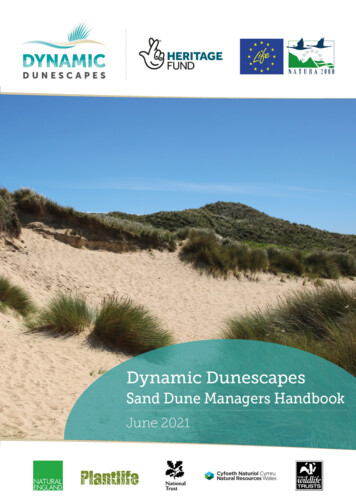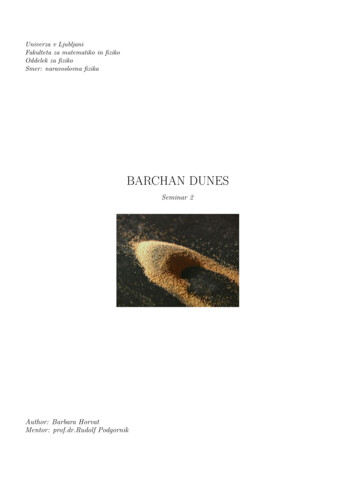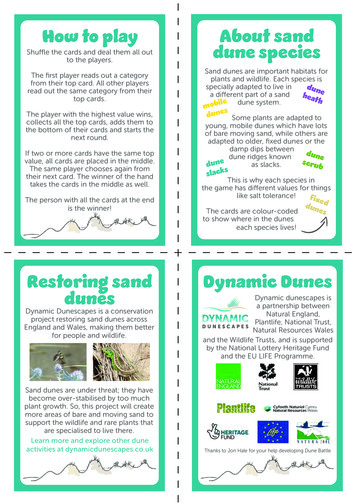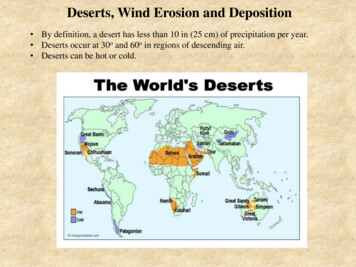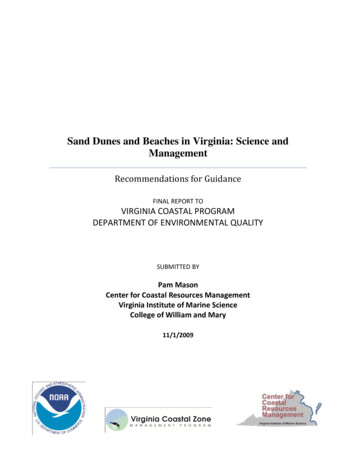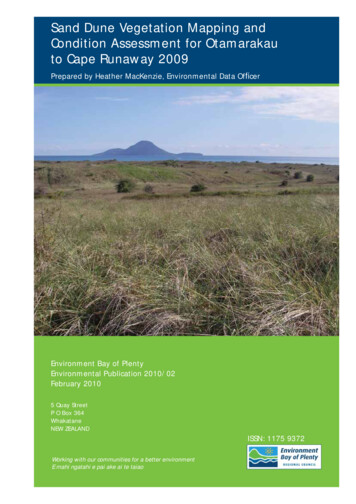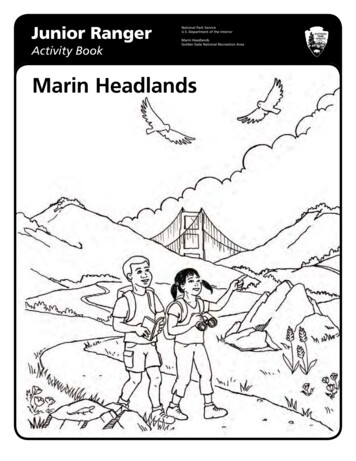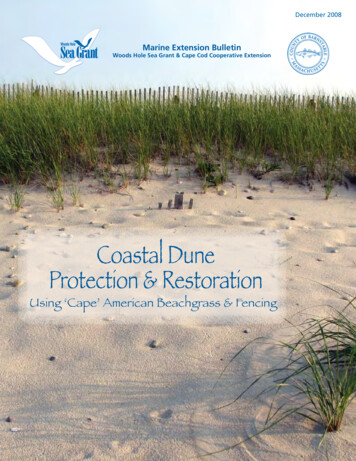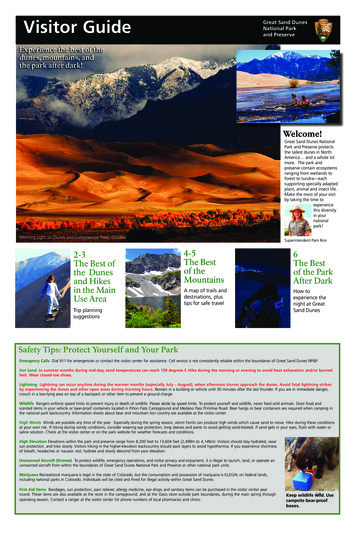
Transcription
Visitor GuideGreat Sand DunesNational Parkand PreserveExperience the best of thedunes, mountains, andthe park after dark!Medano Creek, MayWelcome!Great Sand Dunes NationalPark and Preserve protectsthe tallest dunes in NorthAmerica and a whole lotmore. The park andpreserve contain ecosystemsranging from wetlands toforest to tundra—eachsupporting specially adaptedplant, animal and insect life.Make the most of your visitby taking the time toexperiencethis diversityin yournationalpark!Morning Light on Dunes and Cottonwood Trees, October2-3The Best ofthe Dunesand Hikesin the MainUse AreaSuperintendent Pam Rice4-5The Bestof theMountains6The Bestof the ParkAfter DarkA map of trails anddestinations, plustips for safe travelHow toexperience thenight at GreatSand DunesTrip planningsuggestionsSafety Tips: Protect Yourself and Your ParkEmergency Calls Dial 911 for emergencies or contact the visitor center for assistance. Cell service is not consistently reliable within the boundaries of Great Sand Dunes NP&P.Hot Sand In summer months during mid-day, sand temperatures can reach 150 degrees F. Hike during the morning or evening to avoid heat exhaustion and/or burnedfeet. Wear closed-toe shoes.Lightning Lightning can occur anytime during the warmer months (especially July – August), when afternoon storms approach the dunes. Avoid fatal lightning strikesby experiencing the dunes and other open areas during morning hours. Remain in a building or vehicle until 30 minutes after the last thunder. If you are in immediate danger,crouch in a low-lying area on top of a backpack or other item to prevent a ground charge.Wildlife Rangers enforce speed limits to prevent injury or death of wildlife. Please abide by speed limits. To protect yourself and wildlife, never feed wild animals. Store food andscented items in your vehicle or bear-proof containers located in Piñon Flats Campground and Medano Pass Primitive Road. Bear hangs or bear containers are required when camping inthe national park backcountry. Information sheets about bear and mountain lion country are available at the visitor center.High Winds Winds are possible any time of the year. Especially during the spring season, storm fronts can produce high winds which cause sand to move. Hike during these conditionsat your own risk. If hiking during windy conditions, consider wearing eye protection, long sleeves and pants to avoid getting sand-blasted. If sand gets in your eyes, fush with water orsaline solution. Check at the visitor center or on the park website for weather forecasts and conditions.High Elevation Elevations within the park and preserve range from 8,200 feet to 13,604 feet (2,499m to 4,146m). Visitors should stay hydrated, wearsun protection, and hike slowly. Visitors hiking in the higher-elevation backcountry should pack layers to avoid hypothermia. If you experience shortnessof breath, headaches or nausea: rest, hydrate and slowly descend from your elevation.Unmanned Aircraft (Drones) To protect wildlife, emergency operations, and visitor privacy and enjoyment, it is illegal to launch, land, or operate anunmanned aircraft from within the boundaries of Great Sand Dunes National Park and Preserve or other national park units.Marijuana Recreational marijuana is legal in the state of Colorado, but the consumption and possession of marijuana is ILLEGAL on federal lands,including national parks in Colorado. Individuals will be cited and fned for illegal activity within Great Sand Dunes.First Aid Items Bandages, sun protection, pain reliever, allergy medicine, eye drops and sanitary items can be purchased in the visitor center yearround. These items are also available at the store in the campground, and at the Oasis store outside park boundaries, during the main spring throughoperating season. Contact a ranger at the visitor center for phone numbers of local pharmacies and clinics.fall UseKeep wildlife wild.campsite bear-proofboxes.
Hiking and Exploring Main Use AreaArea Shownfrom Dunes ParkingHigh Dune on First Ridge In summer, hike early morning oroevening to avoid 150 F (66oC) sandtemperatures and lightning. View of entire dunefeld Round trip hike: 2.5 miles (4 km) - notrails Elevation gain: 699 feet (213 m) Average Time: 2 hours Hike along ridgesfrom Montville/Mosca Pass TrailheadDunes Overlook View of frst ridge of dunes Round trip hike: 2.3 miles (3.7 km) Elevation gain: 450 feet (137 m) Average time: 2 hoursfrom Point of No ReturnMontville Nature Trail Forest, Mosca Creek, and view offrst ridge of dunes Pick up a trail guide at the visitorcenter during business hours. Round trip hike: 0.5 mile (1 km) Elevation gain: 200 feet (61 m) Average time: 30 minutesMosca Pass Trail Forest, Mosca Creek, meadows,views of forested ridges Round trip hike: 7 miles (11 km) Elevation gain: 1400 feet (427 m) Average time: 3.5 hoursMedano Creek (seasonal) The depth of the creek and length of timethe creek fows is dependent onprecipitation and snow melt. This varieseach year. Follow current and forecast fowon the park website: nps.gov/grsa In an average year, the creek fows Aprilthrough June at the Dunes Parking Area. Peak fow with surge waves typically occursfrom late May to early June. The creek is adjacent to the DunesParking Area, easily accessible for all.Splash, wade or hike upstream/downstream as far as you like along this uniquenatural beach.2 Visitor Guidefrom Piñon FlatsCampground, Loop 2Sand Pit Picnic Area Gentle slopes above Medano Creek Round trip hike to picnic area:1.5 miles (2.4 km) Elevation gain: 400 feet (121 m) Average round trip time: 1 hour Vault toilet Access picnic area directly withhigh-clearance 4WDWellington Ditch Trail From Montville Loop Trail, continue 1mile (1.6 km) on a foothills trail to PiñonFlats Campground.from Visitor CenterSand Sheet Loop Short, interpretivegrasslands trail Round Trip: 0.25miles (0.2 km) Elevation: 50 feet(15 m) Average time: 30minutesCastle Creek Picnic Area 400 foot (121m) dune face rises from creek Hike trail to Sand Pit, then walk alongMedano Creek to Castle Creek. Round trip: 3 miles (4.8 km) Elevation gain: 400 feet (121 m) Average round trip time: 1.5 hours Vault toilet Access picnic area directly withhigh-clearance 4WD.
Plan Your Time: Main Use AreaMosca Creek,along theMontville Trailand Mosca PassTrail, providesa shady retreaton summerafternoons whensand temperatures soar. Lookfor birds andother wildlife inthe lush forest ofthis canyon.2 hours Visit the visitor center for the park flm,exhibits, weather forecasts, park store,and helpful rangers.Explore the dunefeld from the mainDunes Parking Area to walk, splashin Medano Creek (seasonal), or sandsled/sandboard. See below for rentalinformation.Drive your 4WD vehicle along theMedano Pass Primitive Road to SandPit or Castle Creek picnic areas for apicnic.Walk along Medano Creek from theDunes Parking Area, Sand Pit PicnicArea, Point of No Return, or CastleCreek Picnic Area (all dog-friendly).Hike Montville Nature Trail (page 2).3-5 hours, you can also. Hike to the top of the frst ridge of dunes(page 2) for a view of the entire dunefeld.Visit Zapata Falls Recreation Area for arefreshing waterfall and spectacular viewof the dunefeld (page 8).Hike upstream along Medano Creektoward the mountains.Attend an afternoon ranger program.If you have more time: Attend an evening Amphitheater programHike the dunes after dark to experiencestars or moonlight, and natural sounds.Hike Mosca Pass to view wildfowers andlisten to songbirds (page 2).Hike Star Dune, tallest dune in America.Explore the mountains on foot or with a4WD vehicle (pages 4-5).Around sunrise or sunset, view elk,pronghorn, or mule deer in grasslandsfrom pullouts along entrance road.Elk in Grasslands, OctoberBest Ways to Experience the DunesSandsledding and SandboardingBeach PlayDiscover LifeSeven species ofinsects are endemic to thesedunes, including the GreatSand Dunes Tiger Beetle. Look forthem in morning or evening awayfrom the main use area. KangarooRats emerge at night, and bobcats,coyotes, and owls hunt them.Thousands of prairie sunfowersbloom on the dunes in mid-August.Sandsled SandboardSnow sleds and cardboard don’t slide on dry sand. Contactarea retailers for sandsled/sandboard rentals: Oasis Store (outside park entrance) rents equipment fromspring through early fall, 719-378-2222 Kristi Mountain Sports in Alamosa (35 miles from thepark on US 160), open year round, 719-589-9759 Sand Dunes Swimming Pool near Hooper (32 miles fromthe park on CO 17), open year round, 719-378-2807 Mountain View Motor Inn in Fort Garland (32 miles fromthe park on US 160), open year round, 719-379-2993During Medano Creek’s seasonal fow (Aprilthrough June, with peak fow in late May),splash and build sand sculptures. Followcurrent and forecast fow on our website: nps.gov/grsa . When water levels are low from midJune through July, be prepared for mosquitos.Wilderness SolitudeExplore in a Dunes WheelchairCheck out a free duneswheelchair at the visitorcenter, and explore into thedunes beyond the parkingarea. Reserve a child oradult chair in advance at719-378-6395.PhotographyHike away from main use areas to enjoysolitude and quiet in the dunefeld’s 30-squaremile expanse. Plan on 5 hours round trip topyramid-shaped Star Dune, the tallest dune inNorth America; hike down the creekbed to itsbase then up a ridge to the summit. Get a freebackpacking permit to spend the night.Plan your dunes time for earlymorning or evening to capture theevocative wind-sculpted shapesof the dunes. Hike to the top ofthe frst ridge to capture the entiredunefeld (see page 2), or captureabstract shapes and details anywhere in the sand. Other majesticviews are available from pulloutsnear the park entrance, and fromZapata Falls (see page 8).Visitor Guide 3
Best Ways to Experience the Mountains4WD Adventure: Medano Pass Primitive RoadAlpine Lakes and Summits:Hiking, Fishing, andBackpackingUpper Sand Creek Lake 4WD is required for soft sand, creek crossings, and rocks beyond Point of No Return. AllWheel-Drive vehicles are not recommended as they run a high risk of getting stuckOne-way distance to Medano Pass from Horse Trailer Parking Lot: 11 miles (17km), 1.5 hours.One-way distance to Hwy. 69 (beyond Medano Pass) from Horse Trailer Parking Lot: 22 miles(34 km) or 2.5 to 3 hours.Vehicles must be highway-legal in Colorado.Camping is permitted in 21 designated sites along the road in the National Preserve.During dry times, sand may become very soft. 4WD vehicles may have to reduce tirepressure to drive over sand. A free tire pressure station is available at the Amphitheater duringwarmer months.The road closes when creek crossings are high or frozen, when snow is deep, or when theroad may cause vehicle damage. Check the park website for closures and road conditions.A Medano Pass Primitive RoadGuide is available on the parkwebsite or at the visitor center.With a fshing license, fsh fornative Rio Grande cutthroat trout inMedano Creek (catch and release).Watch for bighorn sheep(pictured).Upper and Lower Sand Creek Lakes Large alpine lakes below 13,000 ft. (4,000m)peaks 4WD required to reach higher Music Pass Trailhead; 2WD trailhead at Grape Creek adds 2.5miles each way to hike Fishing (with license; catch and keep to limit) Round Trip Hike to either lake: 8 miles (13 km) Elevation Gain: 2000 feet (610 m) Check with a ranger for climbing routes to steep summits Watch for pikas (pictured) andmarmotsForest Wilderness: Hiking, Wildfowers, and BirdsExplore the forests of Great Sand DunesNational Preserve on-trail or of-trail. Pleasetread lightly to protect plants and habitats.Mosca Pass Trail winds beside Mosca Creekthrough forests, open meadows, and rockyhillsides. Though there are no expansive viewsfrom the trail, you can hike up the slopes abovethe canyon to see the dunes and San Luis Valley.From Mosca Pass, a 1/8 mile (0.4 km) trail tothe southeast takes you to a view into theHuerfano Basin. 4 Visitor GuideMosca Pass Trailhead located 1/8 mile northof visitor centerRound trip hike: 7 miles (11 km)Elevation gain: 1400 feet (427 m)Average time: 3.5hoursWatch for duskygrouse (pictured),woodpeckers, turkeys,and many songbirdsMedano Lake A day hike or overnight trip to forested areas anda small alpine lake, home to native Rio Grandecutthroat trout (catch and release with license). Trailhead accessible by high-clearance 4WDvehicles via Medano Pass Primitive Road Round trip hike: 7.4 miles (12.4 km) Elevation gain: 2,000 feet (610 m) Continue 1.5steep miles tothe summitof MountHerard (13,297feet/4,052m)for a view of thedunefeld.
Directions to TrailheadsMontville/Mosca Pass Trailhead: Drive 1/8 milenorth of visitor center.Point of No Return: 1 mile (1.6km) on Medano PassPrimitive Road, beyond Piñon Flats Campground.This parking area provides access to national parkbackcountry sites along the Sand Ramp Trail.Sand Ramp Trail Access: 5 miles (8km) on MedanoPass Primitive Road, beyond Pinon Flats Campground. This small parking area is accessible by highclearance 4WD vehicles only, providing access tonational park backcountry sites along the Sand RampTrail.Medano Lake Trailhead: Follow sign after driving10.5 miles (17km) along Medano Pass Primitive Road,beyond Piñon Flats Campground. This trailhead isaccessible by high-clearance 4WD vehicles only,providing access to Medano Lake.Music Pass Trailhead: This trailhead is accessiblevia Pass Creek Road, CR 572, located 2 miles (3km)west of La Veta Pass on US 160. The turnof is 39miles from the visitor center or 28 miles west of I-25.Drive 11 miles on CR 572 (unpaved) until the roadturns into CR 570 (unpaved). Take a right on CR 550(paved) and drive 5 miles (8km) to CO 69 (paved).Turn left and drive another 28 miles (45 km) until yousee the “Music Pass” sign. Continue to follow the signson several gravel or dirt roads. 2WD or AWD vehiclesshould park and hike from the USFS Grape CreekCampground. 4WD vehicles can continue for an additional 2.5 miles (4km) to the trailhead.Route to Music Pass Trailhead via Pass Creek RoadCourtesy Google MapsBackcountry Safety TipsCheck the weather forecast before your trip. Planfor rapidly changing weather if you are traveling inhigher elevations. Weather forecasts are available onthe park website or at the park visitor center duringoperating hours.Filter, boil, or treat creek water before drinking.Leave your travel plans with friends or relatives.Wear bright colors during hunting season in GreatSand Dunes National Preserve.Visitor Guide 5
Best Ways to Experience the NightGreat Sand Dunes is one of the best locations in the United Statesto enjoy the night sky. Our distance from urban areas, dry air,and high elevation makes for excellent star viewing on a moonlessnight.Yet there is much more to the night than the sky. Below aresuggested ways to experience nighttime with all your senses inthis unique wilderness.Star and Constellation ViewingDiscover Night LifeMany fascinatinganimals emerge atnight, but their eyesare extremelysensitive to light.Please do not shinefashlights atTiger Salamandernocturnal animals,or you may blind them for over a half hour. Use adim light or red light to protect their night visionand yours. Amphibians such as salamanders havesensitive skin that can become irritated or infectedby the oils and bacteria on human skin. Pleaseenjoy observing them, but do not attempt to pickthem up.To see the most stars, plan to view on amoonless night. Check a moon calendaronline or ask at the visitor center for themoon phase and moonrise/moonset times.The dunefeld has the most open views ofthe sky. Just a short stroll into the sand fromthe Dunes Parking Area provides excellentviewing. Be sure to note the location of theDunes Parking Area in relation to the line ofcottonwood trees so you can fnd your vehiclewhen you return. Alternatively, the SouthRamada Picnic Area or the park Amphitheater provide paved access.Bring your own telescope, binoculars, or just your eyes. There are many free apps that helpyou navigate the night sky on your phone or tablet. The park store in the visitor center has starcharts, nocturnal wildlife books, interactive kits and models, and red LED fashlights to protectyour night vision.Free Evening ProgramsFree ranger programs are ofered at theAmphitheater, just below Piñon Flats Campground,on many evenings during summer and fall. Checkthe program schedule at the visitor center or on thepark website for descriptions of programs oferedduring your stay. The Amphitheater has pavedsurfaces and sidewalk access for wheelchairs. If youare not staying in the campground, park in the lotbelow the Amphitheater.Visitor Guide 6 Nine species of owls inthe park and preserveare more commonlyheard than seen.Listen and watch forowls at dusk as youwalk the MontvilleTrail, Mosca Pass Trail,Wellington Ditch Trail,or Sand Ramp TrailNorthern Pygmy Owl(see page 2). Walk anywhere in the dunefeld to observenocturnal creatures and their tracks. KangarooRats can jump over 5 feet in the air to avoidbobcats, coyotes, owls and other mammals thathunt them in the dunes. Giant sand treadercamel crickets emerge at dusk to feed and fndmates. On wet nights, tiger salamanders andthree species of toads are sometimes observedmigrating in the dunes. When the sun rises, theyburrow down to the moist sand and wait untilthe next rain comes.Enjoy a Full MoonThough few stars are visible during a fullmoon, you can explore the dunefeldwithout artifcial light. Note the locationof the Dunes Parking Area in relation tothe line of cottonwood trees so you canfnd your way back.
General InformationPlease also visit our websitewww.nps.gov/grsaJunior Ranger ProgramWeather InformationGreat Sand Dunes experiences four seasons. No matter what season you are visiting, plan according to daytime and nighttime highs and lows, possible precipitationand wind speeds. Check the weather onthe park website or at the visitor center.Temperatures are relatively cool all yeardue to high elevations, but dry, thin airmakes daytime temperatures feel warmer year round. Winds primarilyoccur in springtime or during regional weather fronts.Daytime highs in the 80s F during summer will create 150 degree F sandtemperatures. Plan to hike the dunes in early morning or evening insummer months.SeasonWinterSpringSummerHighs (F)20s - 30s50s - 70s70s - 80sLows (F)-20 - 1020s - 40s40sFall50s - 70s20s - 40sKids starting at age 3 and older can pick up a freeactivity booklet to earn a badge or patch. The activity booklet takes 30 minutes to 1 hour to complete.For families with more time, kids can participate inthe Junior Ranger Explorer Program by checkingout a backpack with supplies to complete in one dayor overnight. Kids of any age can earn a badge afterrecording feld observations using scientifc tools.The park store has Junior Ranger items such asvests, hats, and other memorabilia.Free Ranger ProgramsFree ranger programsare ofered duringsummer and fall atvarious locations.Check the park website, visitor center,or bulletin boards atPiñon Flats Campground for a list ofprograms.Piñon (Pinyon) Flats Campground The campground is openApril 3 to October 31.Reservations can be made atwww.recreation.gov.Individual sites are 20/nightfor a maximum of 8 peopleand 2 vehicles. Visitors withsenior pass or access passpay 10/night.Check out time is 1 pm.Quiet hours are from 10 pmto 6 am. Generators may runsparingly between 7 am and8 pm.Individual campsites canbe reserved from 6 monthsup to 4 days in advance ofyour arrival day. Sites thataren’t reserved will be madeavailable as frst-come, frstserved.Sites in Loops 1 and 2 aresuited for tents or RVs.Three group sites in Loop 3 can be reserved 12 months inadvance. Prices range from 65- 80. Tents only in group sites.There is a fll station and a dump station, but no hookups for RVs.Flush toilets and sinks are available in each loop.All camping equipment must ft within established tent pad andcampsite to minimize ground disturbance and impacts tovegetation and wildlife habitat.A camp store is located between Loop 1 and 2 for the sale of frewoodand other amenities. Firewood collection is strictly prohibited.AccessibilityAccessible restrooms are available at the VisitorCenter, campground, and Dunes parking lot.In the campground, sites # 10, #14, and #63 areaccessible. Evening amphitheater programs arealso accessible, with paved sidewalks and seating area. Adult and child sand wheelchairs areavailable upon reservation at 719-378-6395 orin person at the Visitor Center. These specialchairs can be used at the Dunes Parking Lot which has anaccessible mat to the creek as well as a viewing platform.PetsLeashed pets are allowed in day useareas of the national park (including the play area of the dunefeld andcampground) and in the national preserve, but not in backcountry areasof the national park. Protect your petfrom 150o sand temperatures by avoiding the dunes mid-day during summer. Take plenty of water for your pet.It is unlawful to leave your pet unattended for any amount of time in yourvehicle or in public spaces. Clean up after your pet to ensure the nationalpark and preserve is a welcoming place to visit.Park PartnersSince 1938, WNPA has advancededucation, interpretation, research,and community engagement to ensurenational parks are increasingly valued byall. All net proceeds from the park storesupport National Park Service researchand programs. www.wnpa.orgFounded in 1989, Friends of the Dunessupports cultural, educational, andresearch activities at Great SandDunes National Park and Preserve.www.greatsanddunes.orgVisitor CenterThe visitor center is open daily year roundexcept for winter federal holidays. Hoursfrom Labor Day weekend to Memorial Dayweekend are 9 am to 4:30 pm. Call 719378-6395 for summer hours. The visitorcenter ofers ranger assistance, passportstamps, lost and found, park flm, exhibits,restrooms, backcountry ofce, and a parkstore.Video MicroscopeVisitor Guide7
Great Sand DunesNational Park and Preserve11500 Highway 150Mosca, Colorado 81146General information (recorded, 24 hours)719-378-6300Visitor Center and Park Store719-378-6395www.nps.gov/grsaemail: grsa interpretation@nps.govEXPERIENCE YOUR AMERICANearby Campgrounds, Lodging, and Public LandsRio Grande National ForestSouth Zapata LakeFrom Zapata Falls Recreation Area, hike 10 miles(16km) round trip to an alpine lake belowEllingwood Peak (14,042 feet/4,280m).Blanca Peak is the fourth highest peak in Colorado at 14,345 feet (4,372m). 16 mile round trip hike to its summit fromtrailhead; shorter hike with high-clearance 4WD on very rough LakeComo Road.Area WetlandsSan Luis Lakes StateWildlife AreaMain lake open yearround; wetlands closedFeb. 15 to July 15 fornesting. Located onLane 6N. 719-3782020.Blanca WetlandsLocated 14 miles SE ofMosca; from Highway17, take County Road 2S east 7 miles. Closed for nesting Feb.15-July 15.Nearby Campgrounds and LodgingGreat Sand Dunes Oasis (near park entrance) Tent camping and RV sites with hook-ups, camp store, gasstation, sandsled and sandboard rentals, restaurant (open Maythrough September), and duplex motel are open April - October.719-378-2222 or visit www.greatdunes.comGreat Sand Dunes Lodge (near park entrance) Modern motel with indoor pool, open mid-March throughOctober. Located up the hill above the Oasis Store.719-378-2900 or visit www.gsdlodge.comZapata Falls Campground (8 miles south of park entrance) Primitive BLM campground; no water or hookups; compost toilets. Bumpy gravel access road. Open year round, but access roadis not plowed in winter. No reservations. 11 per night.719-852-5941 (BLM ofce in Monte Vista open Mon.-Fri.;no phone at campground)San Luis Lakes State Wildlife Area (15 miles west of entrance) Tent camping and RV sites with electric hook-ups, no potablewater. Colorado Wildlife Annual Permit is required for entry. is8 Visitor GuideNational Wildlife Refuges Alamosa and Monte Vista NWR open yearround, 719-589-4021. Baca NWR Visitor Center is open to the public;call 719-256-5527 for hours.Zapata Falls Recreation AreaThis 20 ft. (7m) high waterfall cascadeswithin a narrow crevasse, and the areaincludes spectacular views of the entiredunefeld and valley. Drive 8 miles south tothe large Zapata Falls Recreation Area sign,then drive 3 miles up the very bumpy gravelroad. Hike 1/2 mile (800m) on a trail to thecreek. You must wade through water intothe crevasse to view the falls. Watch for falling rocks or ice.Water is cold, and may be swift and deep in early summer. The fallsand creek are frozen in winter and spring. Primitive campground,picnic tables, and mountain biking trails are also available. BLM,719–852–5941.
the national park backcountry. Information sheets about bear and mountain lion country are available at the visitor center. High Winds. Winds are possible any time of the year. Especially during the spring season, storm fronts can produce high winds which cause sand to move. Hike during these conditions at your own risk.
